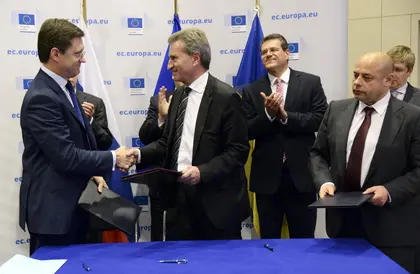Ukraine will be able to buy Russian gas at $378 per thousand cubic
meters until the end of the year and for $365 in the first quarter of 2015. Prepayments
will require Ukraine to pay $760 million for November supplies and another $760
million for December to get additional 4 billion cubic meters of blue fuel this
year.
Concerning Ukraine’s massive debt to the Russian gas supplier Gazprom,
Ukraine will pay $1.45 billion now and $1.65 billion by the end of the year, recognizing
the price of $286 per thousand cubic meters, which is the price ex-president
Viktor Yanukovych got in December from Russian leader Vladimir Putin.
JOIN US ON TELEGRAM
Follow our coverage of the war on the @Kyivpost_official.
Also, there will be no “take-or-pay” clause or volume
restrictions for Ukraine. The total package is worth $4.6billion. Ukraine expects
financial backing from the International Monetary Fund and the EU to cover
expenses.
This comes just in time, since despite the government’s plans to manage
with just 26 billion cubic meters until the spring, energy analysts had
calculated that Ukraine would suffer a shortfall of 4-5 billion cubic meters.
“Unprecedented levels of EU aid will be disbursed in a timely
manner, and the IMF has reassured Ukraine that it can use all financial means at
its disposal to pay for gas,” the European Commission said in an Oct. 31 statement.
“Further work with international financial institutions on financial
assistance to Ukraine, also in relation to gas supplies, will still continue.
But all three sides are reassured that Ukraine will have the necessary
financial means.”
“There is now no reason for people in Europe to stay cold this
winter,” said European Commission President Jose Manuel Barroso. European
Union energy chief Guenther Oettinger said he was confident that Ukraine would
be able to afford to pay for the gas it needed, adding that the agreement might
be the “first glimmer” of hope in easing tensions between Russia and
Ukraine. “This is an important step for our shared energy security on the
European continent,” Barroso said.
The agreed price setting mechanism, via a $100 per thousand cubic meter
discount to the contract price rather than setting a fixed price of $385, as
was previously discussed, is beneficial for Naftogaz in view of declining
oil prices, argues Kyiv-based investment house Dragon Capital. This implies a
gradual 9-month decline in the contract gas price. So, based on the current oil
price level, the gas price for Ukraine is estimated at $378 in the fourth
quarter of this year and $340 in the first quarter of 2015.
Ukraine gains nothing on the price issue, argues analyst Yuriy Korolchuk
of the Institute of Energy Strategy. “The price reduction from $385 to
$378 is a technical matter regulated by the gas price formula, and so was not a
result of the negotiations. Ukraine has not seen the promised (by the
government) $268 or $326.” In short, real savings are minimal.
In addition, the deal offers nothing for the post-March 2015 period, and
so a gas crisis might start anew, Korolchuk says. “Ukraine has exhausted
the financial and monetary resources of the EU and European banking
institutions to pay for gas. And that today is the biggest problem,” he
explains.
The EU might not want to act a negotiator next year and the Ukrainian
government might play the “we don’t need Russian gas” game, instead
relying on an uncertain reverse flow from Europe.
Russia shut the gas taps to Ukraine on June 16 the moment Ukraine filed
a lawsuit in a Stockholm arbitration court on the grounds that Gazprom had been
overcharging Ukraine for gas, and so the multi-billion dollar debt, that
Russian side claims to be $5.3 billion, is exaggerated. Gazprom is
counter-suing on the grounds that Ukraine is a delinquent payer. On Oct. 30
Ukrainian Prime Minister Arseniy Yatsenyuk stated that Ukraine will continue to
pursue the suit.
In 2013, Ukraine consumed an estimated 48 billion cubic meters of gas,
of which 20 billion came from domestic resources, 2 billion were imported from
Europe, and 26 billion were purchased from Russia. The country’s energy
efficiency is among the lowest in Europe. Also, Ukraine remains a major transit
country for the EU, which received 86 billion cubic meters of Russian gas in
2013 – 15 percent of its needs – via Ukraine, earning the government around $3
billion dollars.
Since June 16, Ukraine has accumulated 17 billion cubic meters in its
storage facilities and arranged for reverse gas flows to come from Poland,
Hungary and especially Slovakia for as much as 10 billion cubic meters per
year. On Sept. 2 a “little reverse” pipeline was inaugurated at the
Slovakia-Ukraine border to go around the trunk pipelines, of which Gazprom
claimed it had exclusive use based on existing contracts with Europe. Ukraine
has indicated that it might want to source all of its non-domestic gas from
Europe in the near future.
The text of the Oct. 30 protocol may be downloaded here.
Kyiv Post business journalist Evan Ostryzniuk can be
reached at ostryzniuk@kyivpost.com.
You can also highlight the text and press Ctrl + Enter




